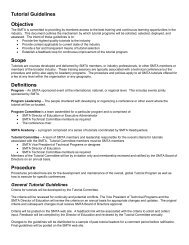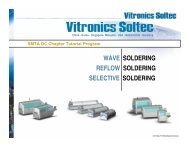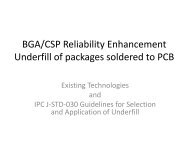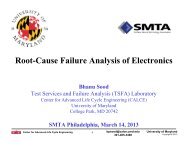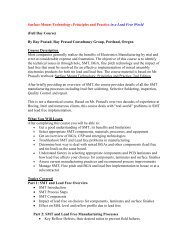a root cause failure mechanism for solder joint integrity - SMTA
a root cause failure mechanism for solder joint integrity - SMTA
a root cause failure mechanism for solder joint integrity - SMTA
Create successful ePaper yourself
Turn your PDF publications into a flip-book with our unique Google optimized e-Paper software.
25 micro inchesFigure 5 SEM cross-section of IG separation of EN nodules6. Small Section Black Band (figure 6)Small section black bands are a higher level of hyperactiveIG, in which spreading is continuous throughout severaladjoining nodules. Small section black band arbitrarilydefined as any continuous corrosion layer spreading that canentirely be viewed at 5000x magnification.200 micro inchesFigure 7 SEM cross-section of corner section black band.100 micro inchesFigure 8 SEM cross-section of large section black band10 micro inchesFigure 6 SEM cross-section of small section black bandFigure 9 shows a plane view micrograph of the black padsurface after <strong>solder</strong> <strong>joint</strong> <strong>failure</strong>. The black pad <strong>failure</strong>usually shows a clean separation at the trans<strong>for</strong>med Nisurface. Little to no Ni/Sn intermetallic is observed at the Nisurface or on the component lead. The back surface has asignature “mud cracked’ appearance and phosphorousconcentrations exceeding 10 wt. %.7. Corner Section Black Band (figure 7)Corner section black band is also a special case of a highlevel of continuous hyperactive IG. In this case thecontinuous corrosion band is confined to the corners oredges of pads. In the observation of the DOE there waseither a lot of corner section activity on the sample, or noneat all. In either case no strong correlation to chemicalparameters could be made.8. Large Section Black Band (figure 8)This is the highest level of IG hyperactivity. At this level thecorrosion consumes large areas of a pad. The corrosion bandthickness has been observed up to ¼ of the bulk Ni layer. IGspikes are also visible in this view and will be shown laterhow spike corrosion progresses to continuous black band.Thick IG is also observed above the black band region,which makes it extremely hard to detect at the platingprocess stage. This is a cross-sectional view of the marginalto non-wetting defect known in the assembly industries as“black pad”.50 micro inchesFigure 9 - Surface structure of the black pad defect.SEM cross-section sample preparation by mechanicalpolishing and etching can sometimes smear out the finestructure that you would like to observe. It is important to





